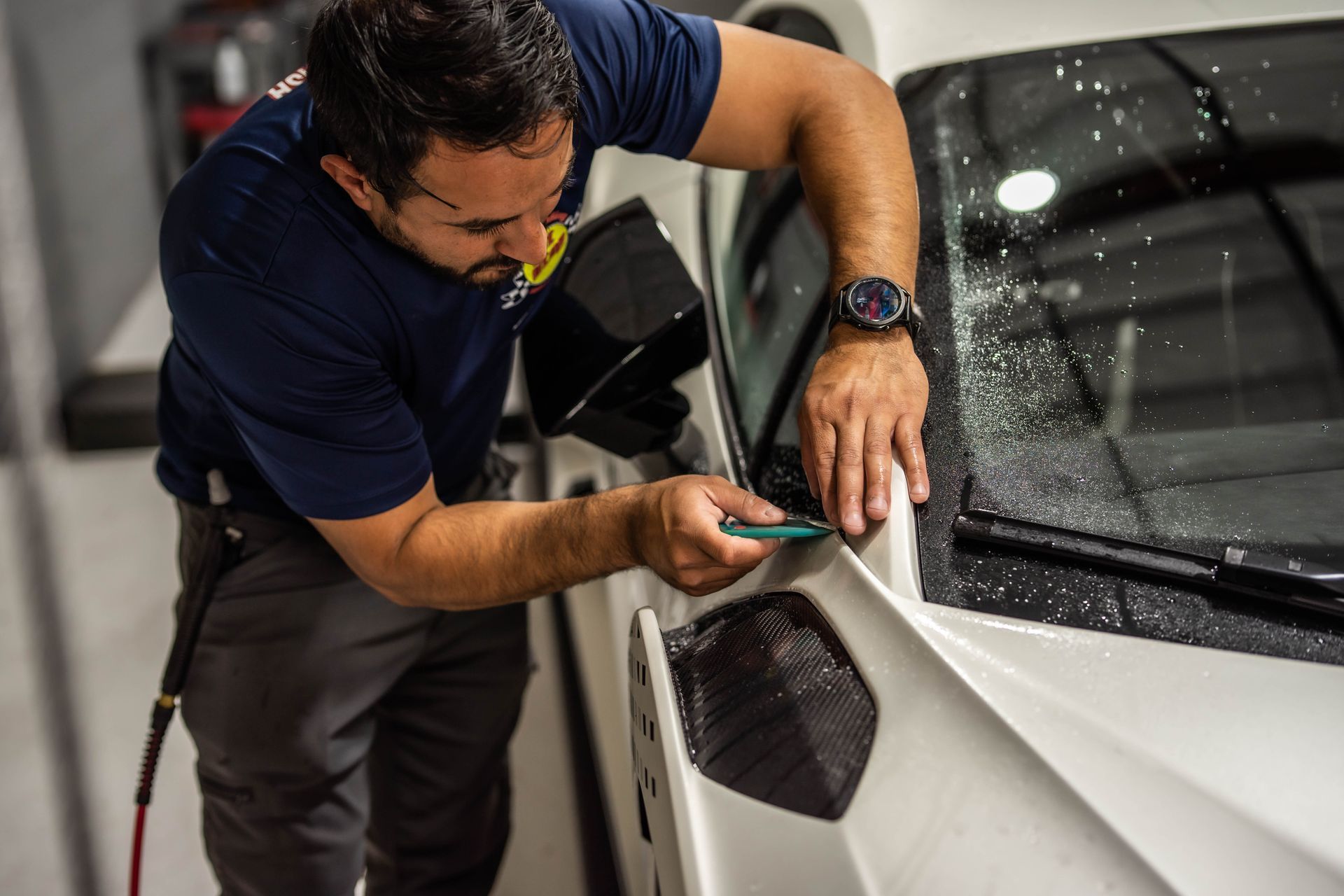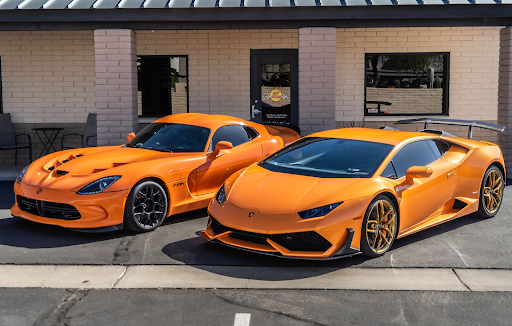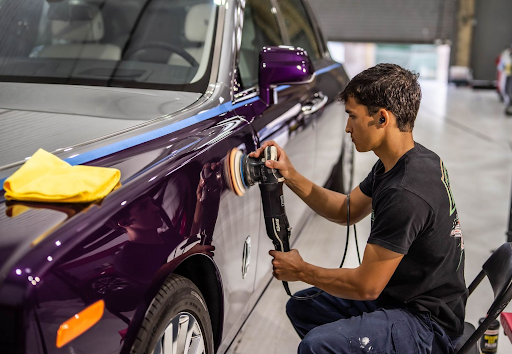PPF: Defend Against Summer Road Debris & Construction Zones
GET A FREE ESTIMATESummer driving season brings open roads, blue skies, and, unfortunately, heightened risks to your vehicle's paint. As temperatures rise, so do the chances of encountering road debris, construction zones, and intense UV exposure that can damage your car's finish. Paint Protection Film (PPF) offers a modern solution to these seasonal challenges, going well beyond what traditional waxes can provide.
This transparent defender forms an invisible shield against impacts while featuring self-healing properties that maintain your vehicle's appearance throughout the summer months and beyond. With more driving comes more exposure to potential hazards, making PPF a smart investment for preserving your car's exterior during the most active driving season.

Understanding Paint Protection Film (PPF)
What is PPF?
PPF is a transparent, thermoplastic urethane film applied to the exterior surfaces of vehicles. This virtually invisible layer adheres to high-impact areas such as the hood, front bumper, side mirrors, and other vulnerable spots. The primary purpose of PPF is to absorb impacts and prevent damage to the underlying paint from various external factors, acting as a sacrificial barrier between your vehicle's finish and the elements.
The Summer Assault: Debris and Construction Zones
Road Debris: A Common Threat
Summer months often see increased traffic and construction activity, creating perfect conditions for road debris. Loose gravel, rocks, and stones kicked up by other vehicles become projectiles that bombard your car at highway speeds. These small objects strike with surprising force, causing paint chips and scratches that mar your vehicle's appearance and can lead to rust if left untreated.
Construction zones present particularly high-risk areas during summer, when road work peaks. These zones often feature uneven pavement, loose materials, and debris that can easily damage your vehicle's paint job.
How PPF Defends Against Impacts
When road debris strikes a PPF-protected surface, the film absorbs and disperses the impact energy instead of allowing it to damage the paint underneath. The thick, durable material creates a buffer zone that prevents small rocks and gravel from making direct contact with your vehicle's finish.
While significant impacts may damage the film itself, the paint beneath typically remains untouched. This sacrificial property means you might need to replace a section of film after severe impacts, but you'll avoid costly paint repairs and maintain your vehicle's original factory finish.
The body content of your post goes here. To edit this text, click on it and delete this default text and start typing your own or paste your own from a different source.
The Sun's Challenge: UV Rays and Heat
The Damaging Effects of UV Radiation
Summer sunshine may feel wonderful on your skin, but it's harsh on your vehicle's paint. Prolonged exposure to ultraviolet radiation causes paint to fade, oxidize, and deteriorate over time. Even PPF itself isn't immune to UV effects—low-quality films can yellow and degrade when exposed to intense sunlight for extended periods.
PPF's Defense Against the Sun
High-quality PPF includes UV protection components that shield your vehicle's paint from harmful rays. This UV-resistant property helps maintain your car's color vibrancy and glossy finish throughout the summer months. Premium PPF can block a significant percentage of UV radiation, preventing the sun-bleached appearance common in older vehicles.
By investing in PPF with strong UV protection capabilities, you're not just guarding against physical impacts—you're also preserving your vehicle's appearance against the invisible threat of solar radiation.
Heat's Impact on PPF
The extreme temperatures of summer can temporarily soften PPF, making it more pliable and potentially more susceptible to damage during the hottest parts of the day. High heat may also affect the adhesive properties of the film in some cases.
We recommend parking in shaded areas when possible, as this simple step helps mitigate heat effects on your PPF and extends its protective lifespan. Using a car cover during extended parking periods provides additional protection from both UV exposure and heat.
Beyond Immediate Protection: Long-Term Benefits
Maintaining Aesthetics and Resale Value
A vehicle with pristine paintwork commands a higher resale or trade-in value than one showing signs of road wear. By applying PPF, you're making an investment in your car's future worth. The film helps preserve that showroom-fresh appearance that potential buyers find so appealing.
The protection provided by PPF means fewer touch-ups and repairs over your vehicle's lifetime, maintaining the factory finish that significantly impacts perceived value when it's time to sell or trade in.
The Advantage of Self-Healing Properties
Modern PPF features remarkable self-healing technology that repairs minor scratches automatically. When exposed to heat—either from warm water, sunlight, or even your car's engine—the film's polymers flow slightly to fill in small surface imperfections. This remarkable property ensures that minor scratches from car washes or light impacts disappear, maintaining a smooth, flawless appearance over time.
Making the Investment: Quality and Installation
Choosing the Right PPF
Not all protection films offer equal performance. Films vary in thickness, with standard options providing good everyday protection and thicker variants offering enhanced durability for high-risk environments. Thicker films generally provide better impact resistance but come at a higher price point.
Material quality directly affects how well the film handles UV exposure, impacts, and environmental stressors. Premium films incorporate advanced UV protection technology that prevents yellowing and maintains clarity throughout the product's lifespan.
The Importance of Professional Installation
Professional installation ensures proper adhesion, precise trimming, and a seamless fit around complex vehicle contours. Experienced technicians use computer-cut patterns specific to your vehicle model, resulting in coverage that looks virtually invisible once applied.
The installation environment matters significantly—moderate temperatures provide ideal conditions for PPF application. The extreme heat of summer can sometimes complicate installation, making spring or fall appointments preferable for optimal results.
Essential Maintenance Tips
To maximize your PPF investment, regular cleaning with pH-neutral products helps prevent contaminant buildup that could damage the film. Avoid harsh chemicals, abrasive tools, or high-pressure washing directly on film edges.
We recommend periodic inspections of your PPF to identify any areas that might need attention, particularly after driving through construction zones or severe weather.
Conclusion
PPF stands as an essential investment for protecting your vehicle's paint, particularly during summer months when road debris, construction zones, and intense UV rays present heightened risks.
At Pit Stop Auto Detailing & Vehicle Storage, we offer premium packages for paint protection film that create a true barrier against these summer hazards. Our PPF provides not just peace of mind but also long-term savings by preventing costly damage while preserving your car's value.
With summer driving season approaching, we invite you to relish the experience of worry-free driving instead of constantly feeling anxious about what might be damaging your paint. Our certified experts provide exceptional PPF installations with meticulous attention to detail, ensuring your vehicle maintains its showroom shine despite summer's challenges.
Schedule online today to protect your investment with our professional-grade PPF solutions that deliver unparalleled protection against Scottsdale's summer road debris and construction zones.
Share with your friends




